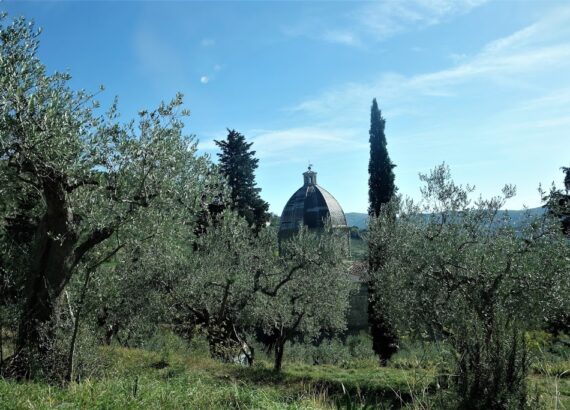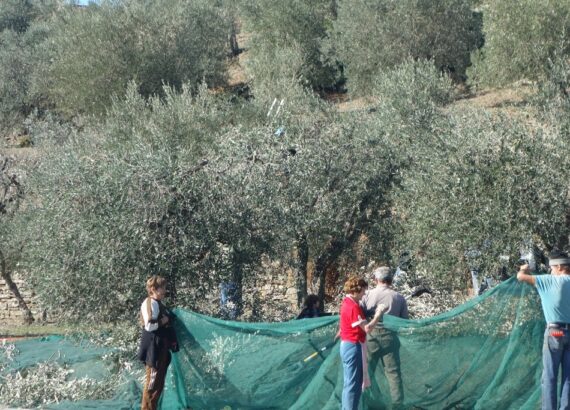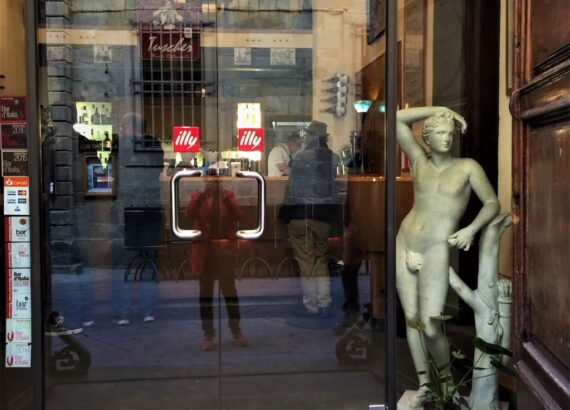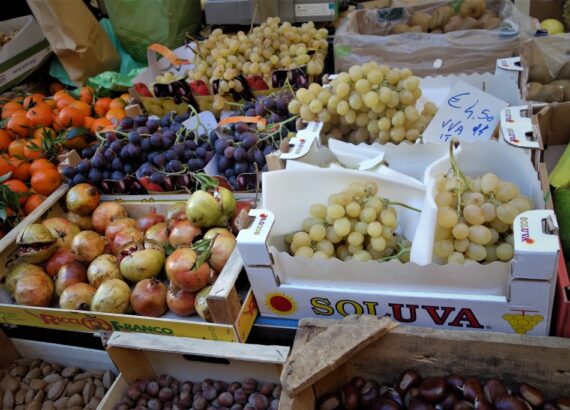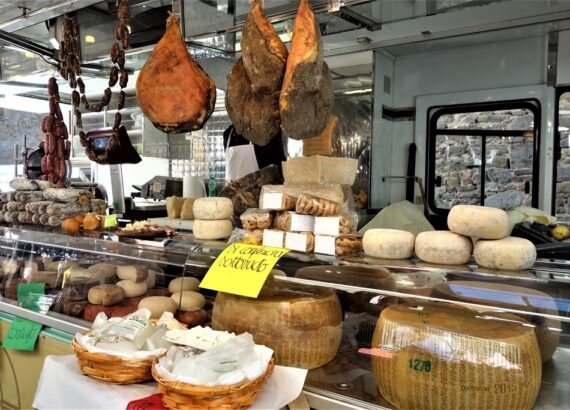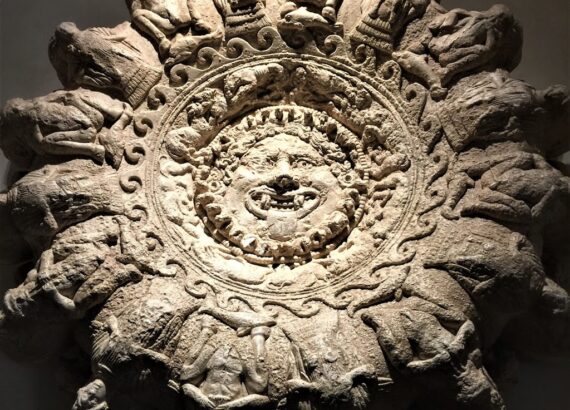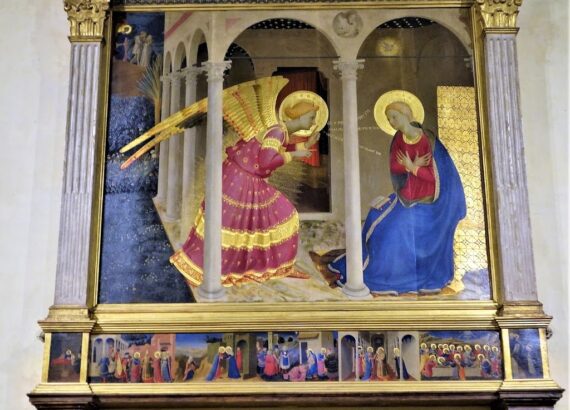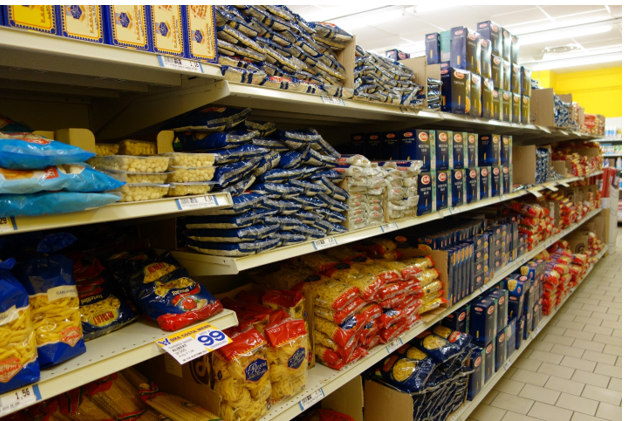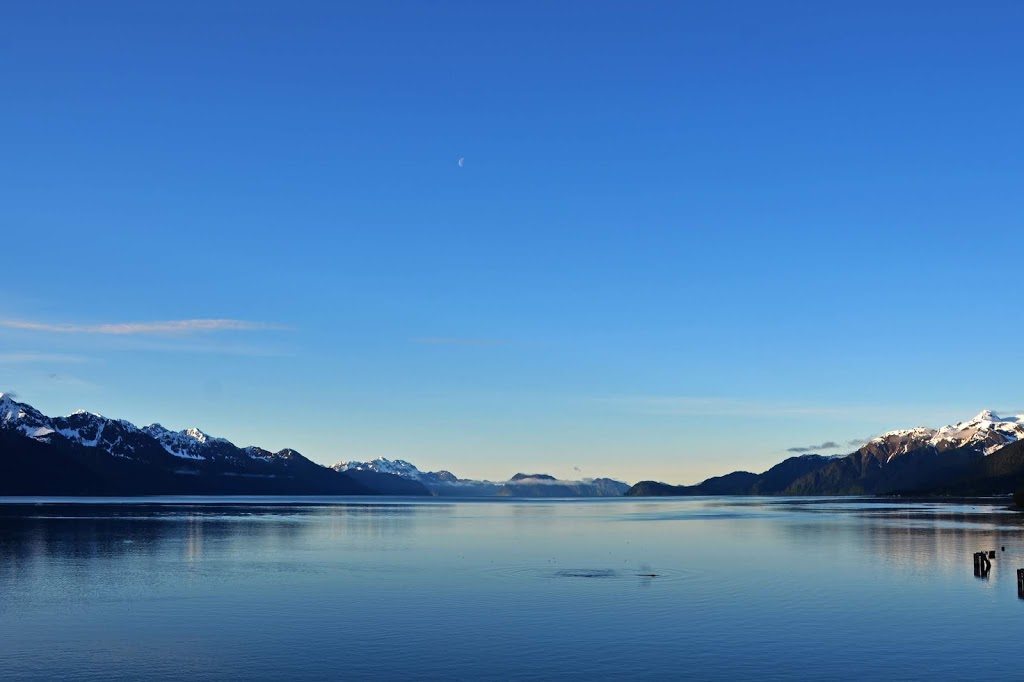A TUSCAN HILL TOWN – CORTONA
My husband and I piled into our friend’s snappy red Alfa-Romeo for the short drive to Cortona. The town is at the top of my list of places in Italy to spend a day, a weekend, or forever. No matter how many times I visit I always want to return to enjoy the lovely ambience. This time it was a sunny late October day. It was early when we left, wispy bits of ground fog hung on low-lying fields and the distant hills were blue-gray. We wound through silvery-leaved olive groves interspersed with cypress trees and an occasional church as we ascended the steep hill leading to the town center.
Harvesters were spreading nets to capture the fruit knocked from the trees by a device on a long pole that shakes the branches. A tractor with a trailer was parked nearby to move the bounty to the frantoio and begin the pressing process where the olives become green-gold liquid.
When we passed an old monastery on a side road I thought back to the time we stayed there long ago: Spartan rooms, two tortoises fighting in the garden (we turned the loser right side up), fabulous view of the countryside and fireflies winking in the soft darkness below our room window. Unfortunately, there was also an air force of vampire mosquitoes feasting on our blood that night courtesy of the unscreened windows. That first weekend in Cortona was memorable for another reason: fungi porcini. Friends each ordered a single mushroom for dinner. I thought they were fasting until the meal was served: the porcini, redolent of the forest, nearly covered the dinner plate. I tried a taste. It was as rich as a steak from the prized Valdichiana cattle that grazed on the plain below the town. Forever more I’ll associate Cortona with those mushrooms.
By the time we reached the main parking lot near the city gardens on the recent one-day visit, the sun was brilliant and the park was full of grannies and children and the inevitable clusters of old men chatting amiably, no doubt about the latest cycle race or soccer game. In the winter the men reminded me of cats moving with the sun; but this was a warm day and the shade of the lime trees was already welcome.
After an espresso and flaky cream-filled cornetto we began to stroll along the main street, Via Nazionale – the only level street in the town.
The street is lined with medieval palazzi, narrow and steep lanes leading both up and down the hill, stylish craft shops, art galleries, bars, and a startling shoe store. We paused, gaping at the men’s selection. I asked my husband if he wanted a pair. When he shuddered at the thought of such a daring fashion move, we walked on to the two main piazzas, linked by a narrow walkway.
The first, Piazza della Repubblica, is the site of the town hall, built before 1240. It is a massive stone palazzo with a wide staircase, old clock, and a bell tower, all emphasizing the importance of the town as an agricultural center in the Middle Ages. On the opposite side of the piazza where tourists sipped a morning cappuccino and rested their feet while locals with shopping bags over their arms chatted with friends, is another medieval palazzo graced by a loggia where a favorite restaurant, La Loggetta, is located. But lunch would have to wait.
Piazza Luca Signorelli, named for the Renaissance painter and native son, is the larger of the two piazzas. And, happily, it was market day.
It didn’t take a moment to dive in to enjoy the experience: glistening fresh fruit and vegetables, shoes, aprons and household goods, salamis and other cured meats. After picking out some of the sweet green grapes that ripen late fall we stopped at the cheese truck. The aroma made my mouth water for a taste of pecorino di Pienza, semi-stagionato. The cheese made from sheep’s milk is aged about 3 months and goes nicely with a glass of Chianti. The Roman army dined on it and it’s never lost popularity, especially with me. We bought a half of a round for snacks when we returned to our friend’s home.
It was time for culture: There are endless temptations but we confined ourselves to our two favorites: the Etruscan Museum, and the Church of the Jesu.
The Etruscans were actually late-comers to the area, the first known inhabitants were likely Umbrians. They were replaced by the Etruscans in around the Eighth Century BC, only to be vanquished themselves by Romans in 90 BC. After the fall of the Roman Empire the town seems to have vanished from history until the Middle Ages, when it began to rise again as a trading center. St. Francis had a convent built in nearby hills in the 1200’s adding to the town’s importance. Intellectuals of the 19
thCentury established the Etruscan Museum that contains a large collection of objects including bronzes. The most famous is a large hanging lamp, that on close inspection would definitely receive a X-rating in today’s world.
Church of the Jesu, now a museum, holds a lovely collection of Renaissance paintings including the sumptuous Annunciation by Fra Angelico as well as several by Signorelli. The Annunciation is a study in pink and gold with the Archangel Gabriele dominating nearly two-thirds of the picture. Golden-haired Mary wears a dark blue robe over a red dress and recedes into the background as the angel with his huge red and gold wings raised as if on the verge of returning to Heaven, points to her with his right hand and with the left issues the tidings. Mary’s response is also in gold letters.
Wikipedia has an interesting commentary on the golden words: “The words of the angel are written on two lines, reading from left to right. [Mary’s words] are between those two lines. If we look attentively we see that her words are written upside-down. But that is not all. Mary’s reply is also written backwards. As a consequence, [an earthly viewer has to stand upside-down,] reading from right to left, to discover what she is saying. This indicates to the viewer that the words are addressed to God, who would be in the proper position to read them.”
My attention always focuses on the angel’s flamboyant appearance. (They always seem so fashionable in paintings of this period.) His hairdo is stylish with a smooth crown supporting a red flame of holiness and tight gold curls around his face and neck. The hair is fascinating but even more beautiful is his gorgeous dress: pink with gold embroidery looking for all the world like the fabric for saris worn by wealthy Indian women. Altogether, a feast for the eyes making me wonder if the painter had access to such fabric and who could have modeled for the picture.
Our eyes filled and time passing, we were ready for another type of feast – a late lunch at La Loggetta. The menu wasn’t extensive but everything was so tempting it was difficult to make a choice. I finally settled on country-style prosciutto with melon followed by gnocchetti with shaved white truffles. Hubby went for fettuccine with fungi porcini and our friend enjoyed pappardelle with hare. Our wine was a Morellino di Scansano, a favorite red with its hint of ripe blackberries.
We were reluctant to leave but none of us could eat a main course.
It was time to return to our friend’s home, itself in a fascinating and ancient Etruscan hill town where she lives in a 600-year old row house on a tiny street called Via Etrusca, the perfect name in this part of the world. That evening we sat by a fire with the grapes, cheese, and a glass of wine to talk travel – past adventures and those we hoped would come.
all photos copyright Judith Works
Like this:
Like Loading...
TAGS
